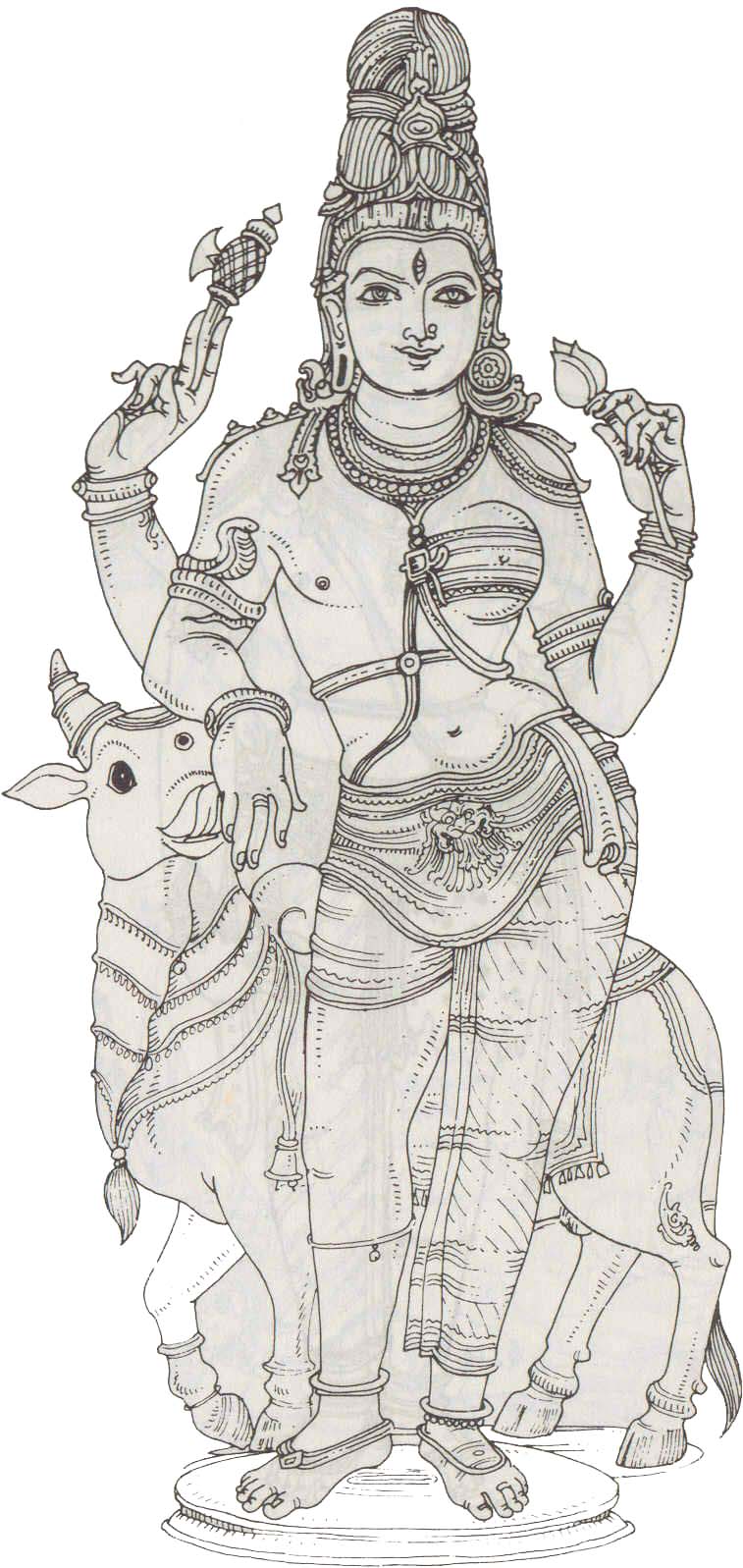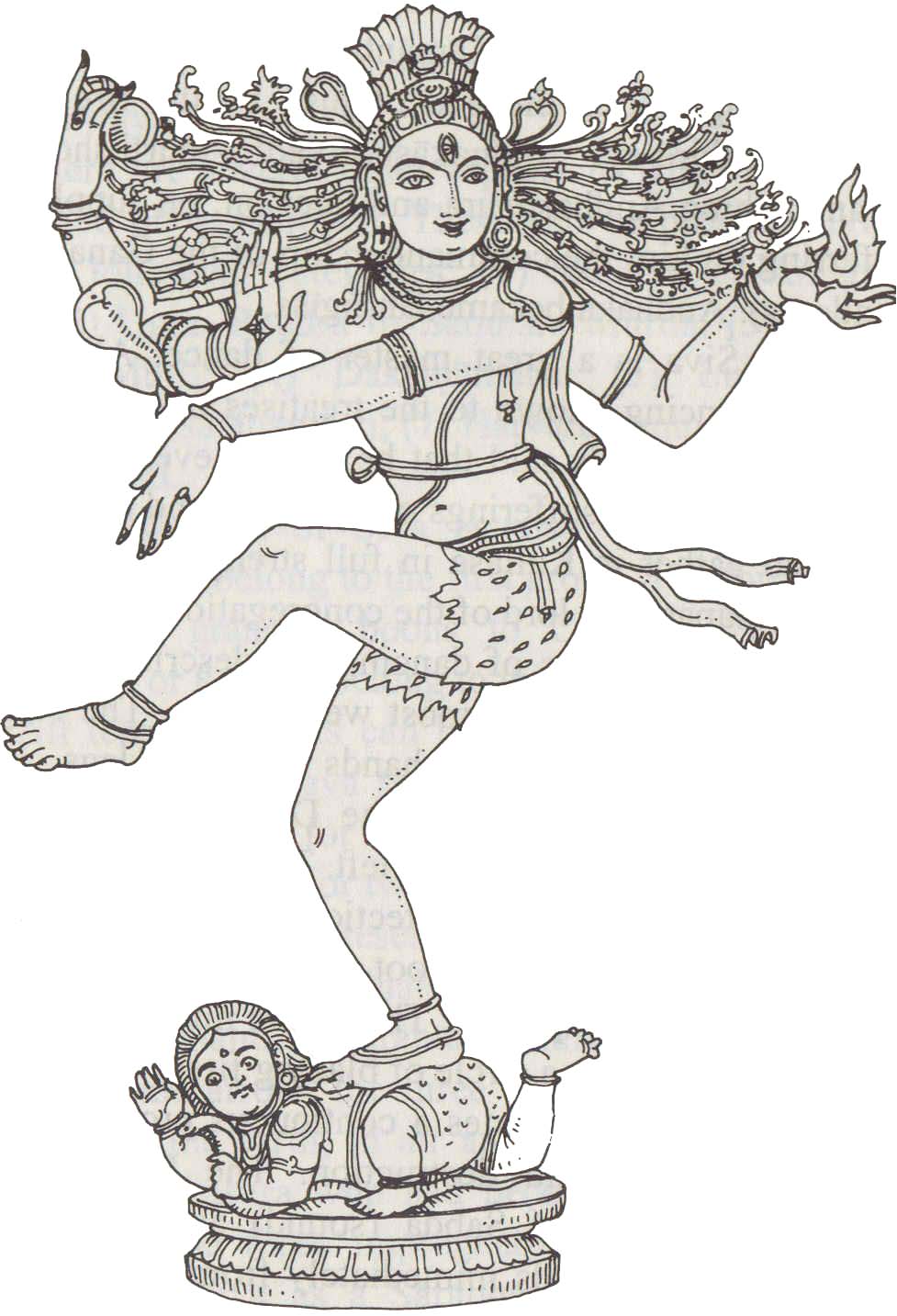| |
|
|
|
|
| Comparable to the Vyuhas or emanations of Lord
Visnu, is the Pancanana form of Lord Siva. Pancanana or the
five-faced one represents the five aspects of Siva vis-a-vis the
created universe. The five faces are respectively Hana,
Tatpurusa, Aghora, Vamadeva and Sadyojata. The face Hana turned
towards the zenith, represents the highest aspect and is also
called Sadasiva. On the physical plane, it represents the power
that rules over ether or sky and on the spiritual plane, it is
the deity that grants Moksa or liberation. Tatpurusa facing
east, stands for the power that rules over air and represents
the forces of darkness and obscuration on the spiritual plane.
Aghora, facing south and ruling over the element fire, stands
for the power that absorbs and renovates the universe. Vamadeva
facing north, ruling over the element water, is responsible for
preservation. Sadyojata, facing west represents the power that
creates. |
|

|
Iconographically, all the five aspects are shown in different
ways.
There are several other aspects in which Lord Siva is depicted
or worshipped. These can be broadly divided into the following
categories: (1) Saumya or Anugraha Murti; (2) Ugra, Raudra or
Samhara Murtis; (3) Nrtta or Tandava Murti; (4) Daksinamurti;
(5) Lingodbhavamurti; (6) Bhiksatanamurti; (7) Haryardhamurti;
(8) Ardhanarisvaramurti.
Peaceful form of Siva as also the form showing mercy and grace
belong to the first group. The forms showing grace or granting
boons to Candesa, Nandisvara, Vighnesvara or Ravana belong to
this category.
All terrific aspects can be classed under the second group.
Kankala Bhairava represents Siva who cut off the fifth head of
Brahma for having reviled him and who had to wander as a beggar
for twelve years to get rid of that sin. Gajasuravadhamurti
represents him as killing the demon Nila (an associate of
Andhakasura) who had assumed the form of an elephant.
Tripurantaka-murti depicts him as destroying by his arrow, the
three cities of iron, silver and gold built on the earth, in air
and in heaven by the three sons of Andhakasura who had become
almost invincible because of these three impregnable shelters.
Sarabhesamurti pictures Siva as a Sarabha (an imaginary animal
more ferocious than the lion) destroying the Narasirhha form of
Visnu, a story obviously conceived by the Saivites to assert the
superiority of their Lord over Visnu! Kalari-murti portrays him
as vanquishing Yama, the god of death, who wanted to take away
the life of Markandeya, a great devotee of Siva. Kamantakamurti
illustrates him as destroying Kama, the god of lust, by the fire
emitted through his third eye. Andhakasura-vadha-murti shows him
as vanquishing Andhakasura and later on, on supplication,
conferring on him the commandership of the Gal)as (dwarf
attendants). Andhaka became Bhrngisa.
Lord Siva is a great master of dance. All the 108 modes of
dancing known to the treatises on dancing have come from him. It
is said that he dances every evening in order to relieve the
sufferings of creatures and entertain the gods who gather in
Kailasa in full strength. (Hence he is called Sabhapati, the
lord of the congregation.)
Only nine modes of dancing are described of which the Nataraja
aspect is the most well-known. The Nataraja icon shows him with
four hands and two legs, in the posture of dancing. There is the
Damaru (drum) in the upper right hand and fire in the left. The
lower right hand is in Abhayamudra (pose of protection) and the
left is pointing towards the uplifted left foot. The left foot
is resting on the demon Apasmarapurusa. The whole image mayor
may not be surrounded by a circle of blazing fire.
Siva's dance indicates a continuous process of creation,
preservation and destruction. The Damaru represents the
principle of Sabda (sound) and hence Akasa (ether), which
proceeds immediately from the Atman and is responsible for
further creation or evolution. Fire represents Pralayagni, the
fire that destroys the world at the time of dissolution of the
world, and hence symbolises the process of destruction. Thus damaru and fire represent the continuous cycle of creation,
preservation and destruction. The other two hands indicate that
he who takes refuge at the feet of the Lord will have nothing to
fear. The Apasmara-purusa (Apasmara=epilepsy) symbolises
ignorance which makes us lose our balance and consciousness. He
is trampled upon by the Lord for the good of the devotees who
take refuge.
Several other dancing postures of Siva like Anandatandava-murti,
Uma-tandava-murti, Tripura-tandava-murti, and
Urdhva-tandava-murti are also mentioned in the Agamas. |
|

|
| |
| Siva is as great a master of Yoga and spiritual sciences as he
is of music, dancing and other arts. As a universal teacher he
is called Daksinamurti. Since Siva was seated facing south (daksina=south)
when he taught the sages in a secluded spot on the Himalayas, he
is called Daksinamurti. He has three eyes and four arms and one
of the legs is trampling upon the Apasmarapurusa. Two of the
arms (the front right and the front left) are in Jnanamudra and
Varadamudra poses (showing the imparting of knowledge and
bestowing of gifts). The back hands hold the Aksamala (rosary)
and, either fire or serpent. He is the very model of the perfect
Guru. He is surrounded by several Rsis eager to learn Atmavidya
(Self-knowledge) from him. |
| |
|
 |
Siva is said to have appeared as a blazing pillar of fire, of
immeasurable size, to destroy the pride of Brahma and Visnu.
Lingodhbavamurti depicts him as manifesting in the heart of the
Linga. The image has four arms. Brahma and Visnu stand on either
side adoring him.
The Bhiksatanamurti shows Siva as a naked Bhairava, begging his
food in the skull cup. It is almost the same as the Kankalamurti.
The Haryardha-murti, also called as Hari-hara and
Sankaranarayana, has Siva on the right half and Visnu on the
left. A fusion of these two aspects into one god is an obvious
attempt at a happy reconciliation of the warring cults of Siva
and Visnu.
The Ardhanarisvara (half man and half woman) form with Parvati
as the left half represents the bipolar nature of the created
world and hence the need to look upon woman as equal and
complementary to man.
MINOR DEITIES ASSOCIATED WITH SIVA
There can be no Siva temple without Nandi, the recumbent bull
placed in front of the shrine. Nandi or Nandikesvara may be
depicted exactly like Siva-with three eyes and two hands holding
the Parasu (battle axe) and Mrga (the antelope). But the other
two hands are joined together in the Anjali pose (obeisance).
More commonly he is shown as a bull-faced human being or just as
a bull.
The Puranas describe him as born out of the right side of Visnu
resembling Siva exactly and given as a son to the sage
Salankayana who had practised severe austerities. Other versions
describe him as the son of the sage Silada who got him by the
grace of Siva.
Nandikdvara, also known as Adhikaranandi, is the head of the
Ganas of Siva and also his Vabana (carrier vehicle).
Symbolically, the bull represents the animal intincts,
especially the sex, and Siva's riding on it reflects his
absolute mastery over it.
Then comes Bhrngi, the sage, who was singularly devoted to Lord
Siva, and was elevated to the retinue of Siva's abode. The sage
was so fanatical in his devotion to Siva that he did not care
even for Parvati, his consort! When Parvati merged herself into
the body of Siva and Siva thus became Ardhanarisvara, Bhrnga was
still so bigoted that he became a Bhrnga (=bee) and bored
through the centre of the Ardhanarisvara form to complete his
circumambulation! Hence the name Bhrngi. Siva, of course, made
him realise his mistake.
Virabhadra is another deity associated with Siva. He is the
personification of Siva's anger manifested during Daksa's
sacrifice because of the contemptuous treatment meted out to
him. Siva is said to have created him out of a hair plucked out
from his head. Virabhadra successfully destroyed Daksa's
sacrifice and humiliated all the gods who had assembled there.
He is usually shown with three eyes and four arms holding bow,
arrow, sword and mace. He wears a garland of skulls. The face is
terrific. Bhadrakali, his counterpart created by Parvati, is
sometimes shown by his side. Siva temples may have a small
shrine dedicated to him, located usually in the south-east.
Next comes Candesvara, a human devotee raised to the status of a
deity, by Lord Siva because of his intense devotion. He is a
fierce deity holding weapons of war and destruction like the
bow, arrow, trident, chisel, noose and so on. Though independent
shrines dedicated to him are not uncommon, he is usually
installed in every Siva temple in the north-eastern comer,
facing south. Devotees believe that he can act as a messenger
and mediator interceding with the Lord on behalf of the
devotees. Hence supplication before him is a duty of every
devotee visiting the Siva temples.
Other attendants of Siva are the Ganas, also known as
Pramathaganas or Bhutaganas (demigods or malignant spirits). If
they are not propitiated, they can do harm. |
| |
| |
| |
|
|
|
|

